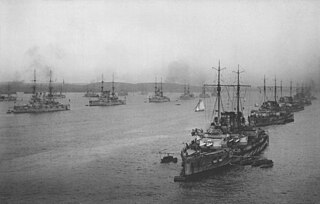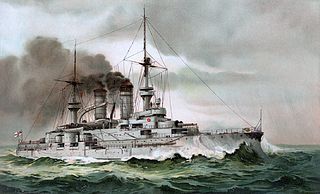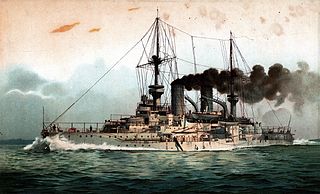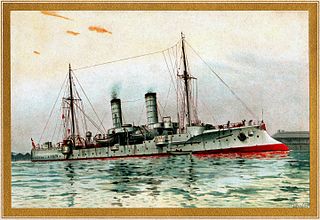
The Imperial German Navy or the Kaiserliche Marine was the navy of the German Empire, which existed between 1871 and 1919. It grew out of the small Prussian Navy, which was mainly for coast defence. Kaiser Wilhelm II greatly expanded the navy. The key leader was Admiral Alfred von Tirpitz, who greatly expanded the size and quality of the navy, while adopting the sea power theories of American strategist Alfred Thayer Mahan. The result was a naval arms race with Britain, as the German navy grew to become one of the greatest maritime forces in the world, second only to the Royal Navy.

Alfred Peter Friedrich von Tirpitz was a German grand admiral, State Secretary of the German Imperial Naval Office, the powerful administrative branch of the German Imperial Navy from 1897 until 1916.

The Bayern class was a class of four super-dreadnought battleships built by the German Kaiserliche Marine. The class comprised Bayern, Baden, Sachsen, and Württemberg. Construction started on the ships shortly before World War I; Baden was laid down in 1913, Bayern and Sachsen followed in 1914, and Württemberg, the final ship, was laid down in 1915. Only Baden and Bayern were completed, due to shipbuilding priorities changing as the war dragged on. It was determined that U-boats were more valuable to the war effort, and so work on new battleships was slowed and ultimately stopped altogether. As a result, Bayern and Baden were the last German battleships completed by the Kaiserliche Marine.

SMS Bayern was the lead ship of the Bayern class of dreadnought battleships in the German Kaiserliche Marine. The vessel was launched in February 1915 and entered service in July 1916, too late to take part in the Battle of Jutland. Her main armament consisted of eight 38 cm (15 in) guns in four turrets, which was a significant improvement over the preceding König's ten 30.5 cm (12 inch) guns. The ship was to have formed the nucleus for a fourth battle squadron in the High Seas Fleet, along with three of her sister ships. Of the other ships only one—Baden—was completed; the other two were canceled later in the war when production requirements shifted to U-boat construction.

The König class was a group of four dreadnought battleships built for the German Kaiserliche Marine in the early 1910s. The class comprised König, the lead ship, Grosser Kurfürst, Markgraf, and Kronprinz. The design for the ships was derived from the preceding Kaiser class, using the same basic hull but with a rearranged main battery of ten 30.5 cm (12 in) guns in five twin-gun turrets to improve the guns' firing arcs. Instead of the staggered wing turrets used in the Kaisers, the Königs placed their main guns all on the centerline using superfiring pairs fore and aft. Budgetary constraints and the need to begin construction quickly to compete with Britain in the Anglo-German naval arms race prevented any more radical changes. Diesel engines were planned for the ships, but they could not be readied in time, so all four vessels reverted to steam turbines for their propulsion system.

SMS Zähringen was the third Wittelsbach-class pre-dreadnought battleship of the German Imperial Navy. Laid down in 1899 at the Germaniawerft shipyard in Kiel, she was launched on 12 June 1901 and commissioned on 25 October 1902. Her sisters were Wittelsbach, Wettin, Schwaben and Mecklenburg; they were the first capital ships built under the Navy Law of 1898, brought about by Admiral Alfred von Tirpitz. The ship, named for the former royal House of Zähringen, was armed with a main battery of four 24 cm (9.4 in) guns and had a top speed of 18 knots.

SMS Westfalen was one of the Nassau-class battleships, the first four dreadnoughts built for the German Imperial Navy. Westfalen was laid down at AG Weser in Bremen on 12 August 1907, launched nearly a year later on 1 July 1908, and commissioned into the High Seas Fleet on 16 November 1909. The ship was equipped with a main battery of twelve 28 cm (11 in) guns in six twin turrets in an unusual hexagonal arrangement.

The Nassau class was a group of four dreadnought battleships built for the German Kaiserliche Marine in the early 1900s. The class comprised Nassau, the lead ship, Rheinland, Posen, and Westfalen. All four ships were laid down in mid-1907, and completed by late 1910. Though commonly perceived as having been built in response to the British Dreadnought, their design traces its origin to 1903; they were in fact a response to Dreadnought's predecessors of the Lord Nelson class. The Nassaus adopted a main battery of twelve 28 cm (11 in) guns in six twin-gun turrets in an unusual hexagonal arrangement. Unlike many other dreadnoughts, the Nassau-class ships retained triple-expansion steam engines instead of more powerful steam turbines.

The Helgoland class was the second class of dreadnought battleships to be built for the German Kaiserliche Marine. Constructed from 1908 to 1912, the class comprised four ships: Helgoland, the lead ship; Oldenburg; Ostfriesland; and Thüringen. The design was a significant improvement over the previous Nassau-class ships; they had a larger main battery—30.5 cm (12 in) main guns instead of the 28 cm (11 in) weapons mounted on the earlier vessels—and an improved propulsion system. The Helgolands were easily distinguished from the preceding Nassaus by the three funnels that were closely arranged, compared to the two larger funnels of the previous class. The ships retained the hexagonal main battery layout of the Nassau class.

SMS Mecklenburg was the fifth ship of the Wittelsbach class of pre-dreadnought battleships of the German Imperial Navy. Laid down in May 1900 at the AG Vulcan shipyard in Stettin, Germany, she was finished in May 1903. Her sister ships were Wittelsbach, Zähringen, Wettin, and Schwaben; they were the first capital ships built under the Navy Law of 1898, championed by Admiral Alfred von Tirpitz. Mecklenburg was armed with a main battery of four 24-centimeter (9.4 in) guns and had a top speed of 18 knots.

SMS Wittelsbach was the lead ship of the Wittelsbach class of pre-dreadnought battleships, built for the Imperial German Navy. She was the first capital ship built under the Navy Law of 1898, brought about by Admiral Alfred von Tirpitz. Wittelsbach was laid down in 1899 at the Wilhelmshaven Navy Dockyard and completed in October 1902. She was armed with a main battery of four 24 cm (9.4 in) guns and had a top speed of 18 knots.

SMS Wettin was a pre-dreadnought battleship of the Wittelsbach class of the German Kaiserliche Marine. She was built by Schichau Seebeckwerft in Danzig. Wettin was laid down in October 1899, and was completed October 1902. She and her sister ships—Wittelsbach, Zähringen, Schwaben and Mecklenburg—were the first capital ships built under the Navy Law of 1898. Wettin was armed with a main battery of four 24 cm (9.4 in) guns and had a top speed of 18 knots.

SMS Schwaben was the fourth ship of the Wittelsbach class of pre-dreadnought battleships of the German Imperial Navy. Schwaben was built at the Imperial Dockyard in Wilhelmshaven. She was laid down in 1900, and completed in April 1904. Her sister ships were Wittelsbach, Zähringen, Wettin and Mecklenburg; they were the first capital ships built under the Navy Law of 1898, championed by Admiral Alfred von Tirpitz. Schwaben was armed with a main battery of four 24-centimeter (9.4 in) guns and had a top speed of 18 knots.

The Gazelle class was a group of ten light cruisers built for the Imperial German Navy at the turn of the 20th century. They were the first modern light cruiser design of the Imperial Navy, and set the basic pattern for all future light cruisers in Imperial service. The design of the Gazelle class attempted to merge the fleet scout with the colonial cruiser. They were armed with a main battery of ten 10.5 cm (4.1 in) guns and a pair of torpedo tubes, and were capable of a speed of 21.5 knots.
The arms race between Great Britain and Germany that occurred from the last decade of the nineteenth century until the advent of World War I in 1914 was one of the intertwined causes of that conflict. While based in a bilateral relationship that had worsened over many decades, the arms race began with a plan by German Admiral Alfred von Tirpitz in 1897 to create a fleet in being to force Britain to make diplomatic concessions; Tirpitz did not expect the Imperial German Navy to defeat the Royal Navy.

The Bremen class was a group of seven light cruisers built for the Imperial German Navy in the early 1900s. The seven ships, Bremen, Hamburg, Berlin, Lübeck, München, Leipzig, and Danzig, were an improvement upon the previous Gazelle class. They were significantly larger than the earlier class, and were faster and better armored. Like the Gazelles, they were armed with a main battery of ten 10.5 cm SK L/40 guns and a pair of torpedo tubes.
SMS Stuttgart was a Königsberg-class light cruiser of the Kaiserliche Marine, named after the city of Stuttgart. She had three sister ships: Königsberg, Nürnberg, and Stettin. Stuttgart was laid down at the Imperial Dockyard in Danzig in 1905, launched in September 1906, and commissioned in February 1908. Like her sisters, Stettin was armed with a main battery of ten 10.5 cm (4.1 in) guns and a pair of 45 cm (18 in) torpedo tubes, and was capable of a top speed in excess of 25 knots.

The High Seas Fleet was the battle fleet of the German Imperial Navy and saw action during the First World War. The formation was created in February 1907, when the Home Fleet was renamed as the High Seas Fleet. Admiral Alfred von Tirpitz was the architect of the fleet; he envisioned a force powerful enough to challenge the Royal Navy's predominance. Kaiser Wilhelm II, the German Emperor, championed the fleet as the instrument by which he would seize overseas possessions and make Germany a global power. By concentrating a powerful battle fleet in the North Sea while the Royal Navy was required to disperse its forces around the British Empire, Tirpitz believed Germany could achieve a balance of force that could seriously damage British naval hegemony. This was the heart of Tirpitz's "Risk Theory", which held that Britain would not challenge Germany if the latter's fleet posed such a significant threat to its own.
















